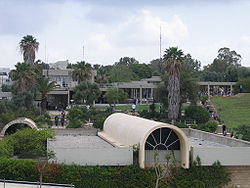Eretz Israel Museum

The Eretz Israel Museum is a historical and archeological museum in the Ramat Aviv neighborhood of Tel Aviv, Israel.

Eretz Israel Museum, established in 1953, has a large display of archaeological, anthropological and historical artifacts organized in a series of exhibition pavilions on its grounds. Each pavilion is dedicated to a different subject: glassware, ceramics, coins, copper and more. [1]The museum also has a planetarium.
The "Man and His Work" wing features live demonstrations of ancient methods of weaving, jewelry and pottery making, grain grinding and bread baking. Tel Quasile, an excavation in which 12 distinct layers of culture have been uncovered, is on the grounds of the museum.

Nechushtan pavilion
Inside the pavilion, visitors find themselves in a reconstructed mine from the Chalcolithic period and the Late Bronze Age, showing marks of mining tools such as stone hammers, flint blades and copper chisels.
Four smelting furnaces are on display:
- Bowl furnace from the Chalcolithic period (4th millennium BCE)
- Domed furnace of the Late Bronze Age (14th–13th centuries BCE)
- Authentic Late Bronze Age furnace (12th century BCE)
- Shaft furnace of the Iron Age (10th century BCE).
Remnants of a glass furnace from the 13th century CE were discovered alongside the Crusader fortress at Sommelaria, north of Acre.
Midianite temple pavilion
In the 14th century BCE, the Egyptian pharaohs dispatched mining expeditions to Timna. Alongside expert metalsmiths from the Land of Midian, they extracted copper at Timna until the early 12th century BCE. This pavilion houses a Midianite temple model. Of special interest is the copper snake with gilded head found in the shrine, perhaps pointing to the biblical Nehushtan (2 Kings 18:4) ("a brazen thing").
Glass pavilion
This pavilion exhibits ancient glass vessels. The exhibition is divided into three sections, representing three eras in the history of glass production: pre-blown glass (Late Bronze Age to Hellenistic period—15th-1st centuries BCE, blown glass of the Roman and Byzantine periods (1st–7th centuries CE); and blown glass of the Islamic period (7th–15th centuries CE). Two rare vessels on display are a delicate drinking horn with two openings, known by its Greek name "rhyton", and "Ennion's Blue Jug" bearing the signature of its maker, who lived in the first half of the 1st century CE.
Philatelic pavilion
The pavilion recounts the history of postal service in the Land of Israel from the mid-19th century until the founding of the state in 1948. On display are envelopes, letters, photographs, posters, mailboxes and telephones, as well as a mail truck from 1949.
The philatelic wing displays valuable and rare stamps.
See also
References
External links
- Official site
- Eretz Israel Museum at ilMuseums.com
